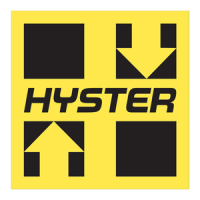Description 4000 SRM 481
1. MAIN CYLINDER
2. FREE-LIFT CYLINDER
3. LOWERING CONTROL VALVE
Figure 1. Lift Cylinders
Spacers are used in some cylinders to limit the stroke
of the piston rod. Worn spacers must be replaced
with the same-size spacer.
During operation, some hydraulic oil will leak past
the piston area to the rod end of the lift cylinder.
Small leaks are permitted if the internal leak rate
of the hydraulic system is not greater than the spec-
ification. An internal check valve is installed in the
piston of the main-lift cylinders. When the piston rod
extends, the pressure increases more quickly on any
oil in the rod end of the lift cylinder. The hydraulic oil
transfers through the check valve to the piston end of
the free-lift cylinder. This action prevents hydraulic
damage to the single lip seal and the wiper ring. See
Figure 3.
Lift cylinders and other hydraulic parts can have
some internal leaks. Internal leakage will increase
as the temperature of the hydraulic oil increases.
The internal leak rate of the hydraulic system is
checked periodically. See the sections Periodic
Maintenance 8000 SRM 1197, Periodic Main-
tenance 8000 SRM 970, Periodic Maintenance
8000 SRM 1379, or Periodic Maintenance 8000
SRM 1027, Maintenance Schedule for your lift
truck and Mast, Repair 4000 SRM 482 for test
procedures and leakage rate specifications.
LOWERING CONTROL VALVE
A lowering control valve (also called a velocity fuse)
is installed in the inlet port of each lift cylinder. See
Figure 2. It permits easy entry of hydraulic oil into
the cylinder, but gives a restriction when the rod is
retracted. This restriction limits the speed that a
load on the forks can be lowered.
There are two types of lowering control valves: low-
pressure designs and high-pressure designs. Both
types have the same function and similar operation.
Themostcommontypeofvalvehasadesignthat
has good operation using large flows and lower pres-
sures. Some lift trucks have a lift system design us-
ing higher pressures and a lower flow. These systems
need a different type of lowering control valve.
The most common type of lowering control valve (low
pressure) uses these parts: (1) a special fitting for
the valve body, (2) a spring, and (3) a special washer.
There is a variation in the shapes of the special
washer. Different lift cylinders use different shapes
of special washers. The volume of the hydraulic oil
flowing through the inlet port controls the shape
of the special washer. A typical shape of a special
washerisshowninFigure2. Whenthepistonrod
is lowered, the oil flow pushes against the special
washer and spring. When the oil flow reaches the
limit, the special washer is moved against the spe-
cial fitting. The oil then flows only through the hole
in the center of the special washer. This restriction
permits the piston rod to lower only at a maximum
controlled speed.
2

